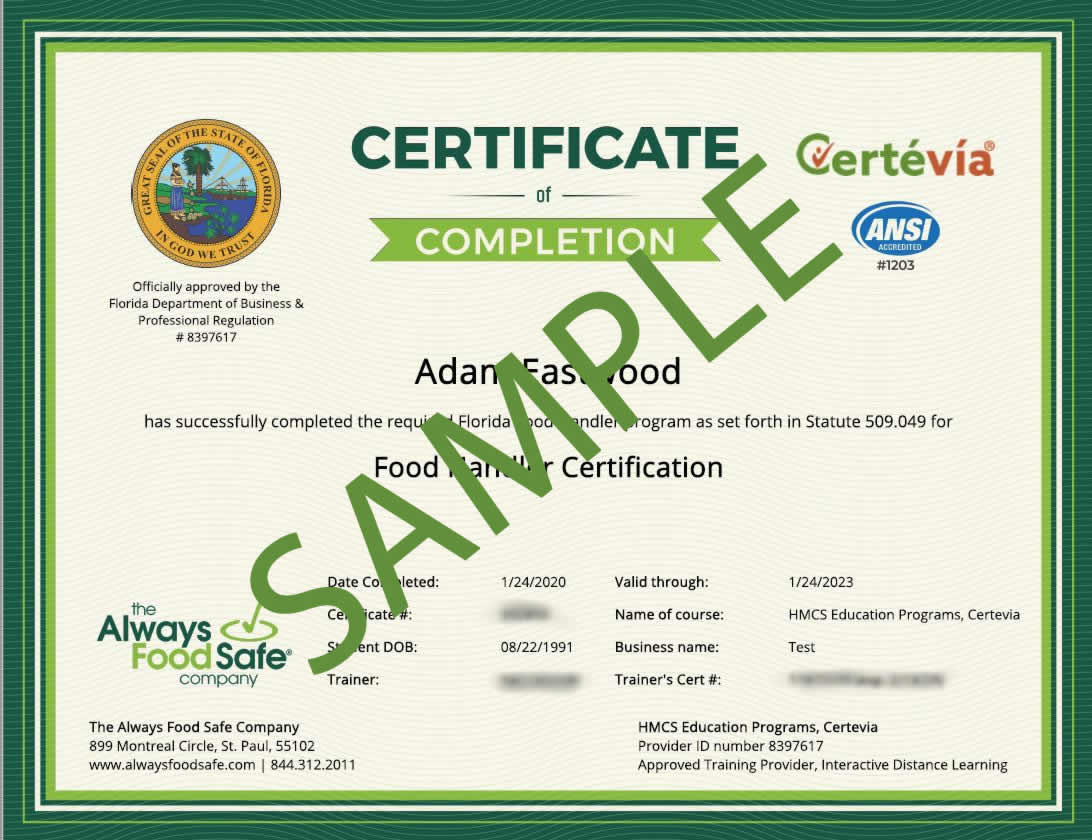Classes for Food Handlers: What You'll Find out in ServSafe Training
How to Get Your Food Handler Certification Quickly and Conveniently
Obtaining your food trainer accreditation can appear difficult, but with a strategic technique, it can be achieved efficiently. Food Handler Certification. What are the most effective strategies to ensure not just an effective certification however additionally continuous compliance in the ever-evolving landscape of food security?
Understand Accreditation Demands
Obtaining a food trainer certification calls for a clear understanding of the details requirements stated by regional health authorities and regulative firms. Each jurisdiction might impose various requirements and assumptions, so it is vital to investigate the laws relevant to your location. Normally, these demands consist of finishing an approved training program, passing a certification exam, and sometimes renewing the qualification regularly.
First, familiarize yourself with the local legislations regulating food security and handling. This may entail checking out the web site of your local health and wellness department or calling them straight for support. Additionally, some areas might have specific age needs or instructional prerequisites, such as a minimum level of schooling.
When you understand the needs, guarantee that the training program you select is identified by your neighborhood health and wellness authorities. This acknowledgment guarantees that the curriculum satisfies the essential standards for efficient training in food safety and security techniques.
Pick the Right Course
Just how can you guarantee that you choose one of the most appropriate food trainer accreditation course for your demands? Start by reviewing the program's accreditation. Validate that it is acknowledged by your neighborhood health department or regulatory body, as this ensures the accreditation will stand for work in your area.
Following, consider the format of the training course. Some individuals may prefer in-person training for its interactive aspects, while others might opt for online training courses for comfort and adaptability. Review the course web content to ensure it covers vital subjects such as food security concepts, personal hygiene, cross-contamination, and correct food storage space.
Additionally, try to find programs that offer a thorough evaluation and technique tests, which can enhance your understanding and retention of the product. Examine the duration of the training course and ensure it straightens with your schedule. Check out reviews or endorsements from previous participants to determine the training course's efficiency and top quality. By meticulously assessing these aspects, you can pick a food handler certification training course that fulfills your specific demands and prepares you effectively for your function in the food solution market - ServSafe Food Handler Card.
Full the Training
Upon choosing the appropriate food trainer qualification program, the next essential action is to complete the training. This training is developed to equip you with important expertise concerning risk-free food managing practices, hygiene, and hygiene protocols. Most training courses provide a combination of on the internet components, videos, and interactive tests, permitting a flexible learning experience that can be tailored to your schedule.
Some courses may also supply situation researches or real-life circumstances to boost your understanding. This useful application of understanding is important, as it prepares you for the challenges you may encounter in a food service setting.
Additionally, guarantee that you designate sufficient time to complete each module completely before relocating on to the following. Rushing with the material can bring about spaces in understanding, which may hinder your efficiency in future assessments. Finishing the training with diligence will certainly not just facilitate a smoother shift to the following action in acquiring your accreditation but likewise guarantee that you are well-prepared to promote food safety and security standards in your expert website link role.
Pass the Qualification Exam
After effectively completing your food trainer training, the following crucial step is to pass the qualification test. This examination is designed to evaluate your understanding of food safety and security principles, methods, and policies that are important in the food service industry.
To prepare properly, examine the materials provided during your training extensively. Emphasis on crucial topics such as correct food storage space, cleanliness practices, cross-contamination avoidance, and individual health requirements. Lots of training programs provide practice examinations, which can dramatically improve your readiness for the real test.


When taking the qualification exam, ensure you comprehend the style-- whether it is composed of multiple-choice inquiries, true/false statements, or functional scenarios. ServSafe Food Handler Certification. Review each inquiry carefully and handle your time intelligently, enabling cautious factor to consider of each solution
If you encounter challenging questions, don't think twice to remove plainly inaccurate options to enhance your possibilities of choosing the right response. After finishing the examination, review your solutions if time authorizations.

Maintain Your Qualification
Preserving your food trainer qualification is important for ensuring recurring conformity with sector criteria and guidelines. Accreditation usually features details demands, consisting of revival timelines and proceeding education and learning. It is important to remain educated about these obligations to prevent lapses in your credentials.
Most jurisdictions need food handlers to restore their certification every 3 to five years. This process typically involves completing a refresher training course or re-taking the accreditation test. Routinely checking your certification's expiry date can help you prevent any kind of possible disturbances in your capacity to function in food service.
Additionally, staying updated on finest practices and changes in food security guidelines is crucial. Joining workshops, participating in industry seminars, learn this here now or subscribing to pertinent newsletters can enhance your understanding and keep you notified concerning the current patterns and compliance demands.
Finally, keeping a clean record in food taking care of methods is equally crucial. File any type of incidents, training sessions, and best practices you implement Visit Your URL at your work environment, as this can work as a beneficial source during renewal or examinations. By proactively engaging in these practices, you guarantee not only the stability of your qualification however additionally the safety and security and complete satisfaction of your customers.
Verdict
Getting food handler accreditation involves an organized method that consists of understanding local demands, picking an appropriate course, completing training, and passing the accreditation examination. By following these steps faithfully, individuals can ensure they are furnished with the required understanding and abilities to support food security standards in their respective environments.
How can you ensure that you select the most appropriate food trainer accreditation course for your requirements? Review the course content to guarantee it covers essential subjects such as food safety concepts, personal health, cross-contamination, and appropriate food storage.
By carefully evaluating these elements, you can choose a food handler certification training course that satisfies your certain needs and prepares you adequately for your role in the food service market.
Upon picking the suitable food handler qualification course, the following crucial action is to complete the training.Getting food handler qualification requires a systematic method that consists of understanding regional requirements, picking an appropriate course, completing training, and passing the accreditation exam.